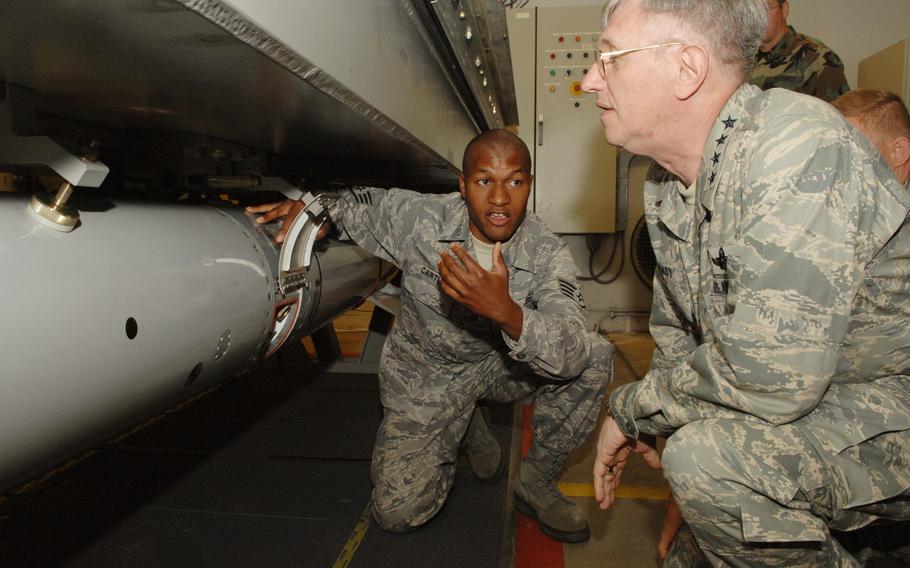
Gen. Roger Brady, then-USAFE commander, is shown B61 nuclear weapon disarming procedures on a inert training version in an underground vault at Volkel Air Base, The Netherlands, on June 11, 2008. (U.S. Air Force)
Russia has used a German television report aired this week as an opportunity to threaten countermeasures against a long-standing and well-publicized U.S. plan to upgrade its tactical nuclear weapons in Germany.
The German broadcaster ZDF claimed in a report aired Tuesday that the U.S. was poised to deploy new nuclear weapons to a base in western Germany later this year.
The U.S. is planning to produce an upgraded version of the B61s currently deployed in Europe, but the upgrade is not slated to be completed until 2020, according to the U.S. government agency overseeing the program and outside experts.
Russian President Vladimir Putin’s spokesman said Wednesday that any such move could alter the nuclear balance between Moscow and NATO. Among the potential countermeasures could be the positioning of Iskander ballistic missiles in the Russian enclave of Kaliningrad, which borders Poland and Lithuania, Russian media reported.
The Pentagon countered later Wednesday that the U.S. is not planning new nuclear weapons for Europe but rather proceeding with a plan to upgrade its aging nuclear arsenal. “Life-extended weapons are not ‘new’ weapons,” said Navy Capt. Jeff Davis, a Pentagon spokesman.
For several years, the U.S. has been developing a plan to refurbish its aging nuclear bombs, with government agencies routinely publishing news releases and test videos on progress of the effort. Known as the nuclear Life Extension Program, the initiative involves upgrades for various nuclear systems. Among the planned upgrades is the B61-12, which would replace the current B-61 in Europe.
“We are proceeding with full-scope nuclear weapon Life Extension Programs to ensure reliability and enhance surety, safety, security and use control — including for those weapons that are forward deployed,” Davis said.
The B61-12 is still in the testing phase, with actual production set for 2020 according to the National Nuclear Security Administration.
The U.S., which has reduced its nuclear arsenal in Europe by 90 percent since the end of the Cold War, maintains the plan is in line with all nuclear treaties with Russia, which has a decided advantage in the number of tactical weapons in its possession in Europe, according to analysts.
The United States routinely declines to give the number of bombs it maintains in Europe and their locations, but various nuclear watchdog groups have reported that the U.S. maintains about 180 bombs in Europe, with a portion of those being stored at a German air base in Buechel, one of the locations for the current B61 bomb.
However, while the U.S. says it is refurbishing old bombs rather than building new ones, critics contend the upgrades will make the B61-12 more accurate, which they say amounts to creating a new weapon.
“This means the B61 will essentially be a new warhead with new military capabilities — a violation of President Obama’s 2010 nuclear strategy,” said Angela Canterbury, executive director of the Washington-based Center for Arms Control and Non-Proliferation. “Why would Europe or the U.S. need new nuclear weapons? Real security will come by leading the world towards disarmament.”
Canterbury added that the upgrade was five years from production.
In Germany, the presence of U.S. nuclear bombs has long been a point of contention among political leaders. Some have advocated their removal, while others favor their continued presence as part of NATO’s commitment to nuclear deterrence.
German Chancellor Angela Merkel has reaffirmed Germany’s commitment to NATO’s standing as a nuclear alliance.
NATO’s Strategic Concept, endorsed by all 28-member states, asserts that “as long as there are nuclear weapons in the world, NATO will remain a nuclear Alliance.”
The presence of nuclear weapons in Germany has been long-standing, and the U.S. plan to refurbish its current stock is hardly new. Russia has been well aware of the plans, with the country’s state media periodically reporting on the developments.
Nonetheless, Russian leaders expressed shock this week.
“It’s another, unfortunately very serious, step toward exacerbating tensions on the European continent,” Russian President Vladimir Putin’s spokesman, Dmitry Peskov, told reporters Wednesday. “It may disrupt the strategic balance in Europe and therefore will make Russia take corresponding countersteps and countermeasures to re-establish the balance.”
Such threats have become somewhat routine. Russia made similar assertions about increasing its military presence in Kaliningrad when the U.S. announced earlier this year that it would pre-position about 250 tanks and other heavy armored vehicles across the Baltics and eastern Europe.
Since Russia annexed the Crimea Peninsula from Ukraine in March of last year, tensions between Moscow and the West have escalated. The U.S. and NATO allies have stepped up the pace of exercises and demonstrations of military strength in the member countries along Russia’s periphery, and Russia has responded in kind with large-scale exercises of its own.
Stars and Stripes reporter Tara Copp contributed to this story.
vandiver.john@stripes.com Twitter: @john_vandiver